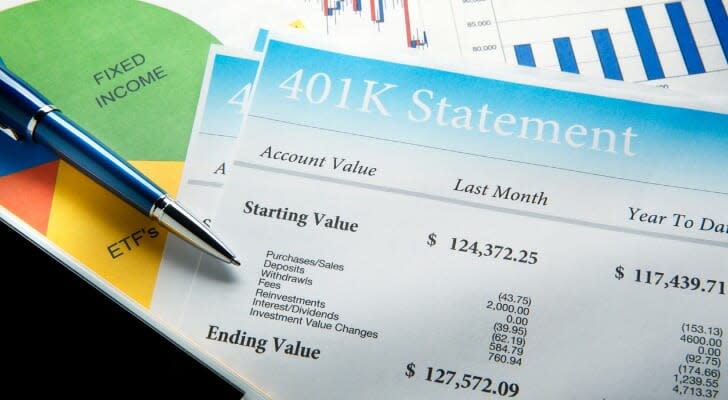Most Americans have less in their retirement accounts than they’d like, and much less than the rules say they should have. So, obviously, if that describes you then you’re not alone.Now, most financial advisors recommend that you have between five and six times your annual income in a 401(k) account or other retirement savings account by age 50. With continued growth over the rest of your working career, this amount should generally let you have enough in savings to retire comfortably by age 65.
Consider working with a financial advisor as you flesh out your retirement plan.
What Your Retirement Savings Should Look Like by Age 50
Financial experts sometimes suggest planning for your retirement income to be about 80% of your pre-retirement income. So, for example, someone who earned $100,000 per year going into retirement would plan on having about $80,000 per year while retired. The reason for this discrepancy is that most households tend to have fewer needs and responsibilities while in retirement, and therefore fewer expenses.The only major exception to this rule is when it comes to healthcare. You should expect those costs to rise in your later years.
To make your savings last, financial experts recommend that you plan on withdrawing about 4% per year from your retirement fund. This will depend on three main factors:
How much money you have in your retirement fund
The average rate of return that your retirement fund generates
Your anticipated Social Security income
So, for example, say you plan on needing $80,000 per year in retirement.
If you’re ready to be matched with local advisors that can help you achieve your financial goals, get started now.
First, you should look up how much money you can expect each month from Social Security. This income will depend on how much you made during your working life, as well as when you choose to retire. If you are an average Social Security recipient it will come to approximately $1,650 a month, or $19,800 a year. So you should plan on withdrawing an additional $60,200 per year to make up the difference.
Applying the 4% rule of thumb, $60,200/0.04, suggests that this household will want about $1.5 million in their retirement fund. Other, more conservative, recommendations suggest making these plans without accounting for Social Security. In that case, you would want about $2 million in your retirement fund.
Don't miss out on news that could impact your finances. Get news and tips to make smarter financial decisions with SmartAsset's semi-weekly email. It's 100% free and you can unsubscribe at any time. Sign up today.
The 4% rule may entail withdrawing too much. It comes from, in part, conservative estimates of your retirement fund’s returns. By the time you retire you should have shifted your portfolio to safe assets. Many retirement funds, with comparatively safe assets, will have a return rate of around 3% to 5% by this point, allowing you to hover right around the replacement rate for your withdrawals.
So someone who earns $100,000 per year will want to have around $1.5 million in their retirement fund by age 65. At age 50, then, many experts suggest that this retiree would need to have – at a bare minimum – around $600,000 up in a 401(k), or other tax-advantaged account. That would give the retiree 15 years to boost their retirement nest egg by an additional $900,000, or grow by an average of $60,000 annually for each of the next 15 years. That is unlikely to happen without significant capital appreciation in the retiree’s tax-advantaged account. Many advisors recommend seeking a rate of return around 7% to 8% to reach the needed $1.5 million.
Reaching the Retirement Finish Line
Besides making sure that the asset allocation of your retirement fund is sufficiently aggressive, there are at least four other steps you can take to get from $600,000 at 50 to $1.5 million at 65.
Max Out Your Catch-Up Contributions
This is the most important thing you can do. The IRS limits how much you can contribute to 401(k), individual retirement account (IRA) and Roth IRA in a single year. After you turn 50 it raises the cap, allowing you to make what are called “catch up contributions.” In 2022, for example, most workers can only contribute up to $20,500 to their 401(k) account. However, anyone age 50 or older can contribute up to $27,000. That extra $6,500 is significant, and between age 50 and age 65 it has time to add up to something very real.Take advantage of it.
Open Simultaneous Retirement Funds
The IRS allows you to contribute to a 401(k), an IRA and aRoth IRA in the same year. However, there is overlap between the contribution limits for an IRA and a Roth IRA.
If you are already maximizing your contribution limits to your 401(k) but are still concerned that it isn’t enough, consider opening an IRA or a Roth IRA to supplement your savings. Doing so will allow you to put money into multiple retirement accounts at the same time, helping you to boost your savings considerably.
If you already have simultaneous retirement accounts, consider simply opening an earmarked account. Even though it won’t see the same tax advantages, there’s no reason that you can’t save for retirement with an ordinaryinvestment portfolio. You can put as much money into it as you like then just plan on leaving it there for retirement.
Manage Debt, Manage Spending
An excellent way to free up some cash is to stop making interest payments on debt. If you have existing debt, paying it off more quickly will reduce the amount that you spend on interest and fees. This will, in turn, give you more cash to dedicate toward your retirement account.
When it comes to long-term debt, like a mortgage, paying it off more aggressively can also reduce your potential expenses in retirement. You won’t have to make those payments, which can reduce the amount of money you’ll need each month once you’ve stopped working.
At the same time, consider your overall lifestyle. If you think you may not have enough for your retirement, are there ways that you can shift your lifestyle over the long run that will reduce expenses? Is there someplace less expensive you could live, for example? This isn’t as simple as skipping your morning latte. Instead, consider whether you can shift your monthly needs in a way that might significantly change your budget both today and in retirement.
Consider Working More and Retiring Later
If you don’t have enough money to fund additional retirement accounts, consider taking on additional work to earn that money. This can range from freelance or gig work to a formal part-time job.
This is not a recommendation we make lightly. By the time you’re in your 50s, the last thing most people will want to do is “hustle.” However, secondary work is a good way to boost your finances, and if you need the money for retirement then it has to come from somewhere. More importantly, while it would be unpleasant to need a second job at 55, it would be far worse to need a job at 75. Working today might help ensure that you don’t have to do so tomorrow.
The jump in Social Security payments from normal retirement age to 70 is significant.If you were born between 1943 and 1954, If you start receiving benefits at age 66 you get 100% of your monthly benefit. Should you start receiving retirement benefits at age 67, you’ll get 108% of the monthly benefit because you delayed getting benefits for 12 months. If you start receiving retirement benefits at age 70, you’ll get 132% of the monthly benefit because you delayed getting benefits for 48 months.
Bottom Line
Most financial experts suggest that retirees should have around five to six times their annual income saved up in their retirement account by age 50. If you haven’t hit that mark, it’s probably a good time to maximize catchup contributions and consider opening one or more additional retirement accounts. In addition, make sure your investments are poised for capital appreciation, which of course entails more risk, and cut your discretionary spending.
Tips on Retirement Planning
We can all use help with our finances, and never more so than when it’s time to save for retirement. That’s where a financial advisor can offer valuable guidance and insight.
Finding a qualified financial advisor doesn’t have to be hard. SmartAsset’s free tool matches you with up to three financial advisors who serve your area, and you can interview your advisor matches at no cost to decide which one is right for you. If you’re ready to find an advisor who can help you achieve your financial goals, get started now.
Use SmartAsset’s 401(k) calculator to get a quick estimate of how much you’ll have in your 401(k) by the time you retire.
Photo credit:©iStock.com/Andranik Hakobyan, ©iStock.com/AndreyPopov,©iStock.com/DNY59
The post How Much Should I Have in My 401(k) at 50? appeared first on SmartAsset Blog.


